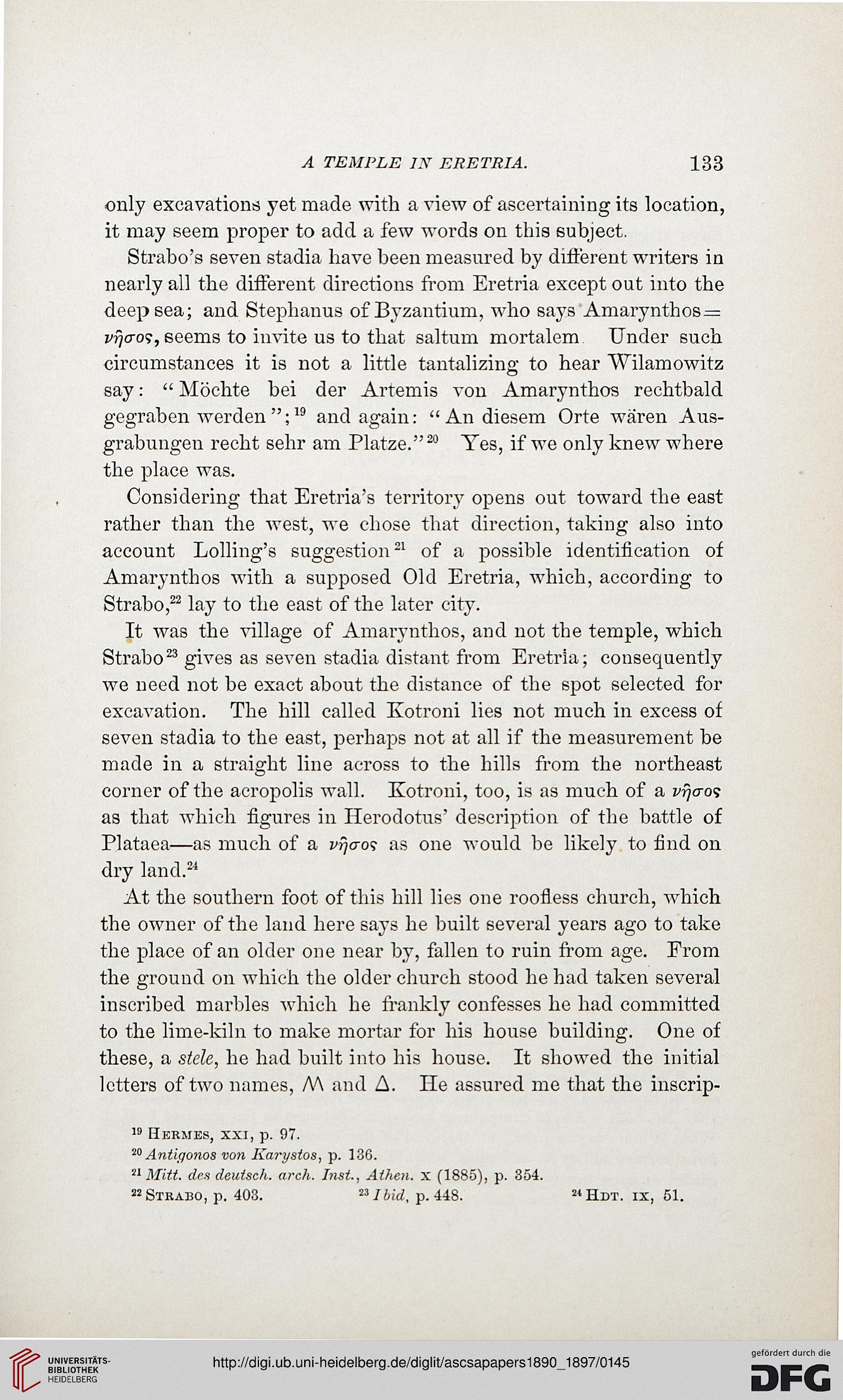A TEMPLE IN ERETRIA.
133
only excavations yet made with a view of ascertaining its location,
it may seem proper to add a few words on this subject.
Strabo's seven stadia have been measured by different writers in
nearly all the different directions from Eretria except out into the
deep sea; and Stephanus of Byzantium, who says Amarynthos^
vr/aos, seems to invite us to that saltum mortalem Under such
circumstances it is not a little tantalizing to hear Wilamowitz
say: " Mochte bei der Artemis von Amarynthos rechtbald
gegraben werden ";19 and again: " An diesem Orte waren Aus-
grabungen recht sehr am Platze."20 Yes, if we only knew where
the place was.
Considering that Eretria's territory opens out toward the east
rather than the west, we chose that direction, taking also into
account Lolling's suggestion21 of a possible identification of
Amarynthos with a supposed Old Eretria, which, according to
Strabo,22 lay to the east of the later city.
It was the village of Amarynthos, and not the temple, which
Strabo23 gives as seven stadia distant from Eretria; consequently
we need not be exact about the distance of the spot selected for
excavation. The hill called Kotroni lies not much in excess of
seven stadia to the east, perhaps not at all if the measurement be
made in a straight line across to the hills from the northeast
corner of the acropolis wall. Kotroni, too, is as much of a vrjaos
as that which figures in Herodotus' description of the battle of
Plataea—as much of a vfjao<; as one would be likely to find on
dry land.24
At the southern foot of this hill lies one roofless church, which
the owner of the land here says he built several years ago to take
the place of an older one near by, fallen to ruin from age. From
the ground on which the older church stood he had taken several
inscribed marbles which he frankly confesses he had committed
to the lime-kiln to make mortar for his house building. One of
these, a stele, he had built into his house. It showed the initial
letters of two names, M and A. He assured me that the inscrip-
19 Hermes, xxi, p. 97.
20 Antiqonos von Karystos, p. 136.
21 Mitt. den deutsch. arch. Inst., Ailien. x (1885), p. 354.
3J Strabo, p. 403. aIbid, p. 448. mHet. ix, 51.
133
only excavations yet made with a view of ascertaining its location,
it may seem proper to add a few words on this subject.
Strabo's seven stadia have been measured by different writers in
nearly all the different directions from Eretria except out into the
deep sea; and Stephanus of Byzantium, who says Amarynthos^
vr/aos, seems to invite us to that saltum mortalem Under such
circumstances it is not a little tantalizing to hear Wilamowitz
say: " Mochte bei der Artemis von Amarynthos rechtbald
gegraben werden ";19 and again: " An diesem Orte waren Aus-
grabungen recht sehr am Platze."20 Yes, if we only knew where
the place was.
Considering that Eretria's territory opens out toward the east
rather than the west, we chose that direction, taking also into
account Lolling's suggestion21 of a possible identification of
Amarynthos with a supposed Old Eretria, which, according to
Strabo,22 lay to the east of the later city.
It was the village of Amarynthos, and not the temple, which
Strabo23 gives as seven stadia distant from Eretria; consequently
we need not be exact about the distance of the spot selected for
excavation. The hill called Kotroni lies not much in excess of
seven stadia to the east, perhaps not at all if the measurement be
made in a straight line across to the hills from the northeast
corner of the acropolis wall. Kotroni, too, is as much of a vrjaos
as that which figures in Herodotus' description of the battle of
Plataea—as much of a vfjao<; as one would be likely to find on
dry land.24
At the southern foot of this hill lies one roofless church, which
the owner of the land here says he built several years ago to take
the place of an older one near by, fallen to ruin from age. From
the ground on which the older church stood he had taken several
inscribed marbles which he frankly confesses he had committed
to the lime-kiln to make mortar for his house building. One of
these, a stele, he had built into his house. It showed the initial
letters of two names, M and A. He assured me that the inscrip-
19 Hermes, xxi, p. 97.
20 Antiqonos von Karystos, p. 136.
21 Mitt. den deutsch. arch. Inst., Ailien. x (1885), p. 354.
3J Strabo, p. 403. aIbid, p. 448. mHet. ix, 51.




